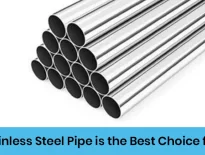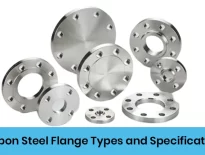Tubes and pipes made from copper-nickel alloy, otherwise known as cupronickel, are gaining favor in many industrial applications because of their remarkable ability to resist corrosion, withstand heat, and maintain structural integrity. At Solitaire Overseas, we make a full range of high-quality copper-nickel products that serve (among others) the heat-exchanging, oil-and-gas, and marine sectors.
What Are Copper Nickel Tubes and Pipes?
Alloys that are mainly made of copper and nickel, along with small amounts of iron and manganese, are found in the pipes and tubes of ships. These copper-nickel alloys are capable of withstanding high pressures, and shipboard engineers are confident that they will not corrode even in seawater and that they will transfer heat very well.
Introduction to Cu-Ni Alloys
The 70/30 cupronickel alloy is perfect for applications like:
-
- Marine hardware and fittings, where durability is crucial
- Heat exchangers in power plants and chemical processing
- Desalination plants, where resistance to harsh conditions is essential
- Shipbuilding and repair, due to its strength and resistance to corrosion
To review, the two cupronickel alloy types 90/10 and 70/30 have specific features that suit them to different sets of applications in the binge resistant industrial realm. The decision of which alloy to use hinges on the particulars of the job; that is, it depends on the environmental conditions, what kinds of mechanical stresses the components will endure, and, last but not least, how much the whole thing will cost. So, long-winded as it may seem, a way of understanding the very essence of what these alloys are and what they can do is vital for folks making decisions about what materials to use in marine and industrial applications.
Copper Nickel Grades – 70/30 and 90/10 Explained
When small amounts of iron and manganese are added to the 90/10 alloy, it becomes even more ideal for uses like heat exchangers and marine applications precisely because its strength and corrosion resistance are ramped up. Both of these jobs call for a metal that won’t falter, even when exposed to prolonged contact with water.
Copper-Nickel Alloy: An Overview
An alloy of copper and nickel, primarily made up of 70% copper and 30% nickel, is celebrated for its remarkable strength and resistance to corrosion, especially in industrial and marine settings. This composition not only makes it incredibly durable but also gives it superior resistance to corrosion when compared to brass. Moreover, the alloy can be augmented with iron and manganese, which considerably enhances its performance in applications that demand a material with exceptional resistance to corrosion and degradation, such as heat exchangers and seawater systems.
Key Properties of Copper-Nickel Tubes and Pipes
Corrosion is resisted excellently by tubes and pipes made from copper-nickel, particularly under very aggressive conditions such as saltwater and high humidity. But that strength comes with a price. The alloy has a high price tag, but there’s a good reason for it: the energy efficiency that results from using it in components such as condensers and heat exchangers. High efficiency follows from the high conductivity and high corrosion resistance of the alloy.
Durability and Mechanical Strength
Alloyed with nickel, copper can withstand great temperatures and pressures. This is just the first reason why conducting devices made of copper-nickel alloys are such good choices for certain applications. Their resistance to mechanical damage and to thermal fatigue (the kind of mechanical damage that arises when a part expands and contracts with heat) are the second and third reasons why you find them in such adequate orbits.
ASTM Standards for Copper-Nickel Alloys
- ASTM B466 – This standard applies to seamless copper-nickel pipes and tubing made from a single piece of metal with no welded joints. They are meant for the highest-pressure, highest-temperature applications, where system integrity is at risk.They are particularly well-suited for naval environments, where not only high pressure and high temperature but also seawater and other corrosive elements pose significant threats to metal components.
- ASTM B467 – This standard covers pipes and tubes made from welded copper-nickel. These are created by rolling a strip of copper-nickel alloy and welding the edges. Although they aren’t really made for super high-pressure applications, they work great in corrosive environments and are good, lightweight, clear-plumbing-service, almost-to-the-surface-wall-hung-piece-of-furniture applications
Dimensional and Tolerance Guidelines
Solitaire Overseas and similar firms not only offer the default dimensions set by ASTM and international guidelines but also a plethora of custom-sized products to fulfill a variety of specific needs.
Applications of Copper Nickel Tubes and Pipes
- Seawater-Cooling Systems: These systems are used in ships, power stations, and offshore platforms to disperse heat generated from working machines. They have an abundance of copper-nickel tubes that are corrosion-resistant, smooth, and inhibit growth in marine organisms from clogging the pipes and shutting down the designed seawater-cooling system.
- Ship-Ballast Systems: In tandem with seawater-cooling systems, copper-nickel tubes are also used in this naval architecture for another vital system working with seawater. The tubes are used in pumps to move seawater in and out of board ballast systems in ships, which serves to stabilize and balance the vessel as it goes through the water.
- Marine Condenser Tubes: These tubes cool steam back down to water in both naval and coastal devices. Copper-nickel is found in a variety of marine condenser tubes in use on ships and coastal devices. Once again, the reason why copper-nickel tubes are so prevalent in these applications is due to their seawater-corrosion resistance, and biofouling performance are just two of the properties making them ideal for this kind of service.
- Piping in Ship Hulls : Piping systems within ship hulls are vital for transporting the many kinds of liquid required by ships, such as gasoline, lubricants, fresh water, and seawater. The enclosed systems of piping on ships must resist rust and corrosion, so they are often made of copper and nickel alloys, which are not only corrosion-resistant but also tough enough to hold up in the wet, salty environment of shipboard life and in the extreme temperature swings common to the marine climate. Moreover, the safety of these piping systems which carry everything from fresh water to hazardous materials (of which more below) is mandated by the construction and classification rules for steel vessels.
- Offshore Oil & Gas Applications : In offshore drilling and processing operations, hydraulic lines, heat exchangers, and firewater systems are made from copper-nickel pipe. Their non-sparking, non-corrosive properties, particular to copper-nickel, make them ideal for the marine environment, where safety and reliability are paramount.
Heat Exchangers and Desalination Plants
Copper-nickel tubing is used extensively in condensers, heat exchangers, and seawater desalination systems. The way these kinds of tubing are arranged and their dimensions significantly influence the effectiveness of the respective systems. For example, in heat exchangers, the thermal conductivity of copper-nickel can enhance heat transfer efficiency. Why? Because heat transfer is a function of the temperature difference between the transferring mediums and the availability of surfaces where the heat can be transferred. In effect, the tubing acts as a “super-conductor” for heat. In contrast, the tubing is resistant to scaling and fouling. In practical terms, this means that it does not easily accumulate deposits of materials like minerals that would otherwise impair its performance in conducting heat.
Structural Differences and Selection Criteria
- Even though copper-nickel tubes and pipes have a lot in common, they are chosen for different reasons.
- Tubes are selected for uses where they must be more precise, where they are specified by outer diameter and wall thickness.
- Pipes are chosen when the main requirement is the movement of fluids, where they are specified by standard bore sizes.
When performance is considered, a pipe rated for 90 psi can take more stress than a tube rated for the same 90 psi. That’s because of pipe vs. tube design and specs. When you consider wall thickness and outside diameter, some of the time you’re better off with a tube; other times, you’re better off with a pipe. When it comes to flowing stuff, though, and flowing is a compressible thing, a pipe wins hands down.
Why Choose Copper Nickel Alloys?
Alloyed copper displays an excellent performance in high-salinity, high-pressure environments and conditions. Penetrating through the resistance of natural corrosion and natural biofouling, it ensures a long equipment lifespan and a range of economic and environmental benefits associated with that equipment. Offerings from the copper-nickel family are on the low side of computational sensing; both alloys are very weak magnetic materials. Additions of copper to nickel serve to lower the density of the alloy and make it much more benign to the kinds of organisms that shield from high-skimming winds. These are forces you would find in coastal and marine environments.
Conclusion
Solitaire Overseas is a well-known manufacturer of pipes and tubes made of copper and nickel. It is reputed for supplying the global market with high-quality products. Its product line includes (1) custom-engineered, super-specialty tubes, (2) standard items that meet ASTM specifications, and (3) a range of items that fall somewhere in between (i.e., from borderline custom-engineered items to borderline standard items). Overall, Solitaire Overseas appears to do an excellent job serving the needs of its customers.


